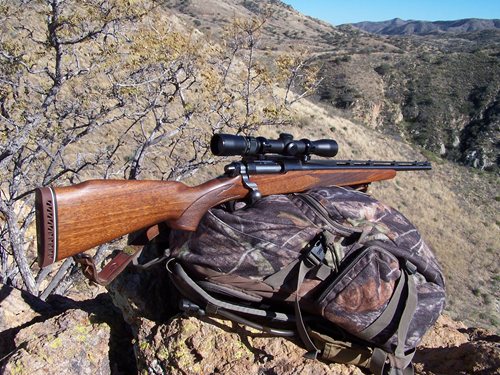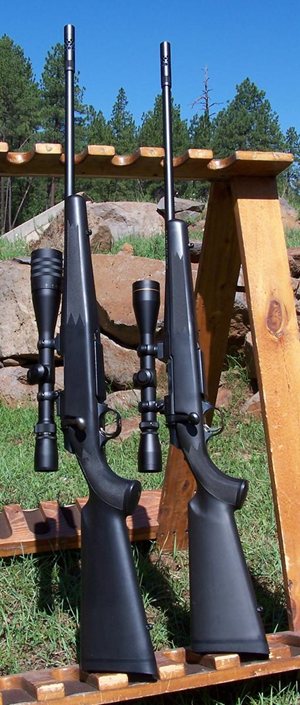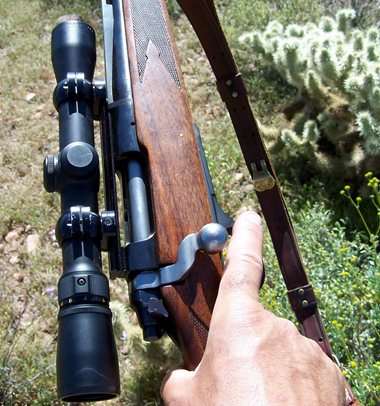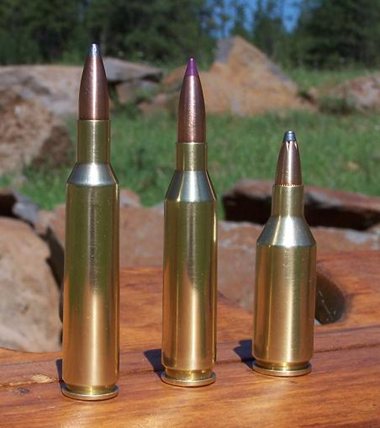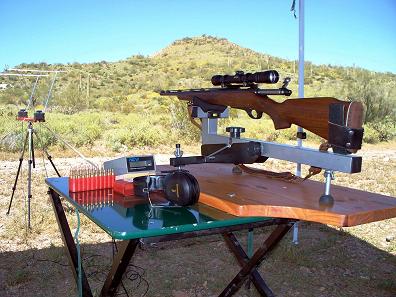
| Articles | Documents | Equipment | Events | Links | Membership | Miscellaneous | Scrapbook | Targets | What's New |
| The Mild Bunch Part 3: 6mm | April 2008 | ||||||||||||||||||||||||||||||||||||||||||||||||||||||||||||||||||||||||||||||||||||||||||||||||||||||||||||
| Dan Martinez | |||||||||||||||||||||||||||||||||||||||||||||||||||||||||||||||||||||||||||||||||||||||||||||||||||||||||||||
|
This is the third and final installment of my report on “The Mild Bunch”.
We’ve covered the mild 7’s,
primarily the 7mm-08, but with very brief mentions of the 7mm Mauser, the
7mmBR, and the 7-30 Waters.
In part 2, I talked about the
6.5mms; the 6.5 TC/U, the .260 Remington, and the 6.5x55 Swede or Scandinavian.
This time around I’m going to discuss three different 6mm cartridges that turn
out to be almost identical, ballistically: the .243 Winchester, the 6mm Remington,
and the new .243 WSSM.
I seem to have a big mental block when it comes to dropping coin on a bolt action
centerfire .22 or smaller caliber rifle. I just can’t do it. Maybe some day I
might, but not so far.
I guess my mindset is that a bolt action centerfire ought to have the mojo to take
after deer at least. It just doesn’t compute with me to use a vehicle which is
designed for serious big game calibers, to only throw around tiny little pellets
at tiny little critters. I know, I know – it’s just me.
That’s what attracted me to my first 6mm rifle, a Browning A-Bolt Composite
Stalker in .243 Winchester. If I get the itch to go prairie-dogging, I could
load it up with 55 grain pellets of 6mm, not .22 caliber, and get tremendous
velocity, a laser straight trajectory, and devastating terminal ballistics.
For larger varminting, I could load it up with 75 or 80 grain missiles and have
the ultimate coyote whomper. For big game from javelina to mule deer, there’s a
good selection of 90 to 105 grain bullets that will do the job if you do yours.
I’ve heard tales of quite a few elk being taken with the .243 Winchester too.
OK, primarily cows, not bulls, but hey!, they’re still elk!
But do you see what I mean? Why would someone limit themselves with the purchase
of a .223 or a .22-250, when for the same outlay of the green stuff, they could
own a rifle in the much more versatile 6mm caliber?
Ahhh, I hear the naysayers now: “Too much recoil for an extended session of
prairie-doggin’.” Can anyone here spell B.O.S.S.? Yep, my Browning has the
recoil-reducing and accuracy-enhancing Ballistic Optimizing Shooting System
muzzle brake on it. It may seem a little weird to have a brake on a .243, but
with it, the recoil very closely approximates that of a .223.
About the only argument against doggin’ with the .243 that sticks, is that a
.243 burns a lot more powder than a .223, which means more expense, and more
bore wear.
Actually, I’ve never gone on a live prairie dog safari with the .243. However,
my boys and I have used it quite a bit for fun on synthetic prairie dogs while
out playing in the desert. I’m talking about popping water-filled plastic soda
bottles. We’ve got this great spot in the desert where we go to play. There’s
a south-facing cliff where we can line up a bunch of bottles at distances
between 140 to 200 yards. (So are they really simulated rock chucks?) Those
hyper-velocity 55 grain pills really do a number on those bottles. Great fun.
In picking out the rifle, first it had to be a Browning A-Bolt, because you all
already know that that’s my favorite bolt action. And because I wanted it as
cheap as possible, I chose the all-black Composite Stalker, the least expensive
rifle in the A-Bolt lineup.
I must admit though, that the all matte-black rifle did hold a different allure.
With the subdued coloration and that exotic-looking thingy on the end of the
barrel, the rifle does have a “tactical” flavor. For sighting, I added that big
Weaver V-16 scope. It’s a sporting rifle with some pretensions at being a
high-tech sniper instrument.
Mark Snyder came out to one of our desert play sessions one day. Mark has
owned a Sako Forester in .243 Win. since his dad got it for him as a boy.
Mark has taken quite a few critters with his favorite old rifle, including
that great double-drop-tine Kaibab buck he tagged in 1998.
But he had mentioned having some trouble grouping with the gun. He said that
he could hold three in a decent group, but five shot groups inevitably opened
up to about three inches. He brought the gun over one evening and we fiddled
around with free-floating the barrel. We checked the tightness of the action
screws and the scope mounting. We scrubbed the bore real good with
copper-cutting Sweet’s 7.62 solvent.
Short of putting on a new scope, we thought that we had covered all the bases.
But when we shot it out in the desert that day, the rifle was still throwing
3-inch groups.
Mark then got a chance to shoot my Browning. I guess he was really impressed
with how consistently and easily it whacked those bottles across the canyon, and
the rifle’s light touch against your shoulder. Because soon Mark had his own
.243 Browning Composite Stalker.
Actually, he was looking for a rifle that he could share with his daughter,
Audrey. That’s one big reason he wanted a muzzle-braked .243. However, by
this time, Browning had discontinued the BOSS-braked Composite Stalker in .243
Winchester. Instead, they cataloged the rifle in the newly-released .243 WSSM.
I guess I could have mentioned some of the history behind the creation of the
.243 Winchester from the then-new .308 Winchester. But I won’t go into all that.
I don’t want to go real deeply into the genesis of the .243 WSSM either, but
because the cartridge is so new, the subject deserves some discussion here.
In the last couple of years, a number of new cartridges have come out in various
case lengths and in various calibers that are fatter than what we’ve been used
to seeing. In 2001, Winchester introduced the .300 WSM (Winchester Short Magnum).
It’s case diameter ranges from .555” at the base to .538” at the shoulder. It’s
not the earliest, biggest, nor the most powerful cartridge built with this fatter
body diameter, but it has turned out to be the most popular of the recent fat
cartridge introductions.
In 2003, Winchester threw everybody for a loop when they introduced the new
WSSMs (Winchester Super-Short Magnum). .223 and .243 versions were introduced,
with the .257 coming a year later. But instead of just necking the .300 WSM
down to create the smaller-bore cartridges, the bodies were shortened also.
Somewhat bizarre in appearance, fat and super-short they are. But in reality,
calling them Magnums is a bit of a stretch. The .257 was meant to duplicate
the ballistics of the .25-06, while the .243 WSSM turned out to be but a small
increment above the ballistics of the .243 Winchester. As a matter of fact,
the .243 WSSM ends up having almost identical case capacity and performance
as the 6mm Remington.
I don’t believe that Mark has yet had a chance to take the WSSM afield, but
it has served quite well in Audrey’s deadly service. To my knowledge, she
has taken two javelina, one doe, and one cow elk with her Browning.
It is interesting to compare dimensions of the two Browning .243s side-by-side.
Length-of-pull is about the same, so overall, the WSSM rifle is about a half-inch
shorter, though the fore end of the WSSM stock has been shortened more than that.
A couple years back a sportsman-co-worker (not a club member, though I’ve tried)
told me about a dad-of-a-friend who was trying to sell off an old Remington Model
600. He wasn’t positive about the caliber. He tried to tell me that it was
6mm-something-or-other, but I jumped on my hopes that it was a 6.5mm Remington
Magnum.
I played it cool though. I told him that I needed another rifle like I needed
a hole in my head. Well that part is totally true, but I’m afraid that my old
rifle illness is terminal. He brought the rifle to work one day, where I
examined it in the trunk of his vehicle out in the parking lot. OK, so it’s a
6mm Remington. It was in pretty good shape overall, crummy recoil pad, old
Bushnell scope on it.
Kind of a cool old gun, but I certainly did not need to own it. So as
to not create too big of a chance that I’d buy it, I threw out what I
thought was a real lowball offer. Wouldn’t you know, a couple days later, I
got word that my offer was accepted. OK, deep breath. Now it’s time to pony
up. Wife won’t be happy. Oh well.
When the Remington 600 was introduced in the early 60’s, it was a rather
controversial gun. It remains controversial even today, though they are
becoming somewhat collectable, especially the Magnum versions. The M600 has
a number of radical styling features not seen on any rifle up to that time,
many not since.
First it was built on a new short action. This action eventually evolved into
today’s Model 7. The Model 600 has a short 18½” barrel topped with a nylon
ventilated rib. The rib really has no function other than style. At the end
of the rib was a strange “shark fin” front sight.
The bolt handle had an unusual dog-leg bend in it, reminiscent of the M1917
Enfield rifle. On the M600 however, the dog-leg kicked the bolt knob forward,
rather than back as it was on the M1917. Gun writers of the time seemed
disturbed and perplexed about this dogleg. It’s quite obvious to me why this
needs to be so, however.
Because the rear portion of this action is so short, a straight handle would
have come down to get in the way of your trigger finger, especially when you
are holding your finger straight, observing the common gun safety practice of
keeping your finger off the trigger except when ready to fire. The dog-leg
gets the bolt knob out of your way.
The M600 was also introduced along with two new magnum calibers in the Magnum
versions of the M600. These were 6.5mm and .350 Rem. Mags. These calibers
were truly the first short Magnums. This added greatly to the controversy
about the M600. There simply is not enough barrel length in these carbines
for magnum cartridges, even short mags, to achieve optimum velocity. Recoil
and muzzle blast was notable, to say the least.
The M600 Magnums also came out with what at the time was a very unusual
feature: a laminated stock. It had five somewhat thick laminations of
alternating dark and light layers. The standard caliber M600s came with a
much more pedestrian one-piece walnut stock.
So as a result, most of the press, which was mostly negative, was heaped
upon the top-of-line magnum versions, and the standard caliber M600s kind of
got lost in the shuffle. The standard M600s were offered in .222, .223
(very rare and collectable today), 6mm Rem., .308 Win, and .35 Rem.
Mine had lost its shark fin front sight somewhere in its life, but the rib
remained. The first thing I did when it came home was to remove the old
crummy ventilated butt pad, chop the back of the stock about an inch, and
put on a new ventilated pad. The rifle originally had a flat plastic butt
plate, so adding a ventilated recoil pad without cutting the wood back made
the length-of-pull too long. I think I did a decent job of it too, if I do
say so myself.
I hunted javelina with it for the first season with the fixed 4x Bushnell
Banner scope I got it with. The rifle was made in 1965 (serial number
lookup), and that scope has to be the only one it’s ever had. It worked
just fine. However, I’ve now mounted a modern Weaver 2.5-7x28mm variable
on the rifle.
The M600 has become my favorite javelina rifle. Its short and compact size
is wonderful for carrying in and out of that steep and rugged canyon “my”
javelina herd lives in. It’s a joy to carry and it’s fun to shoot.
We’ve talked about the rifles, so now let’s talk a little about the ballistics.
On a couple of really nice spring days in the desert, I took all three rifles
out with a number of different loads, for comparative velocity and accuracy
testing. I didn’t have time to carefully work each load up, so I just looked
at the available data and picked a charge level somewhere between the
recommended minimum and maximum powder weights.
I might as well start with the .243 WSSM, because it’s the easiest to report
on. I have no data to report. It’s not that I didn’t shoot it, it’s just that
I had a lot of trouble with it. I actually tested eight different loads.
When Mark graciously allowed me to borrow it for testing, he also brought over
his reloading dies, some empty, but primed cases, a partial box of 100 grain
Winchester factory loads, and some of his handloads.
Alright, I guess I could report on the factory loads. It’s the 100 grain
Power-Point load. I shot one 5-shot group which averaged 3100 fps and grouped
at 1.9 inches. Mark’s 100 grain handload grouped better at 1.5 inches, but
here’s where I started seeing trouble.
I noticed that it was rather difficult to close the bolt on a loaded round, and
lifting the bolt after firing was even more difficult. I did notice that Mark
had loaded his bullets considerably longer (sticking out from the case farther),
than the factory rounds. Were the bullets jamming in the lands?
When I got home that evening, I ran a fired case through the sizing die and found
that it was very difficult to close the bolt on even an empty full-length-sized
case. Even though the shell holder contacted the bottom of the die, the shell
was not getting sized down enough. Mark’s dies were Reddings, but his shell
holder was an RCBS. Sometimes there can be an incompatibility between dies and
shell holders of different manufacturers.
So Mark went out and got a Redding shell holder. It didn’t help. Now Mark is
going to try a different maker’s dies, but not in time for me to meet the
deadline for this newsletter. All I could do was to push forward anyway. I
cooked up some more loads, all below max, but it was more of the same. Difficult
bolt close, and even more difficult bolt lift. This one is going to take some
more work to come up with reloading recommendations.
During my reloading sessions with the .243 WSSM, I noticed a couple of small
issues that makes reloading these fat cartridges a little different than
reloading standard cartridges.
First of all, my normal powder funnel would not fit over the fatter case. I
had to dig through my stash of seldom-used reloading accessories to come up
with a homemade powder funnel that fits inside the case neck, rather than over
the neck and body as my regular funnel does.
Second, when I noticed the hard bolt lift on my first batch of .243 WSSM
handloads, I stopped firing them and took them home to disassemble. These
fat cases would not fit inside my kinetic bullet puller. To disassemble them
I had to run them up in my reloading press, but with no die installed. At the
top of the stroke, I clamped a set of small vise grips onto the bullet, then
lowered the press ram to pull the case down off the bullet. Needless to say,
after that, the bullet was no longer salvageable.
So lets move on to the other Browning A-Bolt in .243 Winchester. Early on, this
rifle also gave me reloading headaches when I tried to cook up big game loads.
For deer with a .243 Winchester, the usual load is a 100 grain bullet with a
charge of a slow-burning powder such as one of the 4350’s or 4831.
Near-top-velocity loads (but still below recommended maximum) were causing
erratic pressure spikes. Some would shoot fine, but then others from the same
batch would spike in pressure to the point that the case head expanded enough
to expand the primer pockets, causing gas leaks around the primers. Bad scene.
Subsequent attempts to reload those cases resulted in the new primers falling
out of the case.
As a result, I stopped trying to load 100 grain bullets with any of the
slow-burning powders. I switched over to loading only medium burn rate powders
such as IMR4064 and Hodgdon Varget with bullets of 90 grains or less. Results
were now much more predictable and I was a happy camper. I figured that I didn’t
need to chase bucks with the .243 anyway – I had other, better choices in the
gun safe for deer.
Well, for this story, I decided to go back, edging toward those deer loads again
to see what would happen. I tried 38 grains of IMR4350 with a 95 grain Nosler
Ballistic Tip. This charge weight is just slightly above the minimum recommended
charge of 37.5 grains. I got decent accuracy of 1.17”, but velocity was on the
slow side at 2661 fps. But the best part is that I got no unexpected surprises.
The data above represents the average of two 5-shot groups fired for each load.
Another notable load I tried uses the 85 grain Barnes Triple Shock X-Bullet. I
started playing with this bullet when my kids got drawn for Kaibab doe. Game
and Fish would like you to use lead-free ammo on the Kaibab Plateau due to the condors
up there. The 85 grain solid copper bullet is supposed to be able to do anything that
a 100 grain lead-core bullet will do. Using a charge of 36 grains of Varget, accuracy
was decent at under 1½ inches. Velocity standard deviation was excellent, and at 2944
fps, average velocity is certainly respectable. I think that this is the gun’s best
big game load so far. It remains to be seen whether BOSS tuning could shrink the groups
a little further. To date, I’ve never done BOSS tuning on any load with the .243. Too
busy just having fun.
When the Model 600 came home, I just threw together some book loads for it with 100
grain bullets and took it javelina hunting. The only testing I did was to fire it off
of shooting sticks with my butt planted on the ground. I was sighting-in the scope at
about 75 yards at camp on the day before the hunt. Ammo supplies were limited, so I
had to call it “good enough” before I ran out of ammo. The second season, I had just
changed the scope, so I found myself repeating the same procedure yet again. Ok, the
hunts are over, a couple of pigs have come to bag, and now I need to write a story about
6mms. It’s time to finally put the gun on a bench to see how it really shoots.
During my field tests, I never saw great grouping, just “good enough”. I started to think
that this gun, with its thin, short barrel encumbered by a useless, but oh-so stylish
nylon rib, might never see stellar accuracy.
Sure enough, when I bench tested my hunting load, the 100 grain Sierra ProHunter over 37
grains of IMR4064, I achieved groups of around 2½”.
Other loads were even worse. However, one load using the Sierra 80 grain Blitz soft
point varmint bullet over 45 grains of IMR4350 proved to be a winner. It grouped very
well, just a shade over one inch. With an average velocity of just over 3000 fps, this
has the makings of an awesome coyote load.
A better load for big game turned out to be the 95 grain Hornady SST over 40 grains of
a rather new powder, IMR4007SSC. This new powder was announced just about a year ago.
The SSC is for Super Short Cut – yeah, more marketing hoopla. This powder is supposed
to have a burn rate between IMR4064 and IMR4350. It is a stick powder, but with really
short grains.
With this load, I got groups averaging 1¾”. Not great, but not bad either. Velocity
averaged just over 2700 fps. That ought to work. Plus, I should be able to kick up the
velocity with a little more load development work.
Another 1¾” grouper was the 55 grain Nosler Ballistic Tip bullet over 46 grains of Varget.
This little missile came flying out of the M600’s short barrel at about 3600 fps. I wished
that I had some plastic pop bottles out with me that day! Gonna have to load up some more
of these and get back out to play.
After messing around with the finicky .243s, it was a real pleasure to not have any undue
drama with any of the 6mm Remington loads I tried. They all fired fine, no sticky bolt
lift problems, no overworked brass, just a pleasure. Well OK, the M600 did kick more since
it was the only brakeless 6mm I played with.
Well, this wraps up my Mild Bunch series. I hope
you enjoyed it. It would have been nice to cover the mild .25s such as the .250 Savage,
the .257 Roberts, and the .257 Ackley-Improved, but I don’t own any .25s, nor do I know
anyone from whom I might be able to borrow one. I welcome any of you guys to submit
followup Mild Bunch stories of your own to fill in the areas I did not cover, or to expand
on those that I did.
Let’s see if I can talk Mark into giving us an update one day on the .243 WSSM if he can
get the case sizing situation straightened out. Hey Mark, any time you’re ready to go
chrono some loads, let me know.
Taken as a group, the Mild Bunch cartridges as I’ve defined it, will easily accomplish 95%
of what we need hunting rifles to do here in North America, from prairie dogs to elk. They
will do so more economically, with less recoil, and usually with less weight to carry than
larger caliber rifles. So what’s not to love?
© Honeywell Sportsman Club. All rights reserved. | |||||||||||||||||||||||||||||||||||||||||||||||||||||||||||||||||||||||||||||||||||||||||||||||||||||||||||||
|
The Honeywell Sportsman Club is a small group of shooting and outdoor enthusiasts in the Phoenix, Arizona area. Our website is ad-free and completely free to use for everyone. But we do have expenses that we need to cover, such as the web hosting fee and our liability insurance. If you enjoyed visiting our website, found it useful in some way, or if you enjoyed reading this story, please consider tipping us through our PayPal donation jar below. Thanks for visiting, and come back soon. |

|
|
